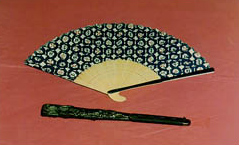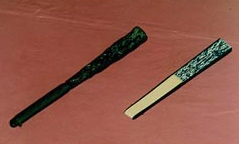|
Tessen: The Iron Fan
|
Fujiyama Dojo P.O. Box 20003 Thorold, ON, Canada L2V 5B3 (905) 680-6389 |
|---|
 Although one of the most versatile weapons of ko ryu bujutsu, the tessen is not as well known today as it once was. Once the formal weapon of a night guard, the palanquin guards, Shogunate officials and police agents, it is now almost a relic from Edo jidai. In classical times, the familiar image of the retainer donning black montsuki, hakama or tatsuke hakama, jingasa and jimbaori would be as incomplete without the tessen as it would be without the swords.
Perhaps it is more often associated with a symbol of authority than with its value as a weapon, but the tessen is without a doubt a useful tool of defense. A formal part of the samurai's training and arsenal, the tessen effectively matched swords and daggers, and were used at the dojos of Chiba. Saito, Momoi and others. Tessen jutsu was included as part of the training for the Kobusho, and in all respects proved its value, to the present day. Although one of the most versatile weapons of ko ryu bujutsu, the tessen is not as well known today as it once was. Once the formal weapon of a night guard, the palanquin guards, Shogunate officials and police agents, it is now almost a relic from Edo jidai. In classical times, the familiar image of the retainer donning black montsuki, hakama or tatsuke hakama, jingasa and jimbaori would be as incomplete without the tessen as it would be without the swords.
Perhaps it is more often associated with a symbol of authority than with its value as a weapon, but the tessen is without a doubt a useful tool of defense. A formal part of the samurai's training and arsenal, the tessen effectively matched swords and daggers, and were used at the dojos of Chiba. Saito, Momoi and others. Tessen jutsu was included as part of the training for the Kobusho, and in all respects proved its value, to the present day.
Types of Tessen
1. Omotebari Kata (Mencho Kata) - A folding fan of moderate elasticity. It's sections number from 8 hon to 20 pon, with 13 bon being the average. Made of materials ranging from bamboo to sheet steel, brass and iron, even whale baleen. 2. Sensu gata - Made of iron and forged in the shape of a closed fan. This rigid tessen is made in two shapes, one with straight sides and another more faithfully resembling a closed fan (known as Tenarishi). The second version is reputedly, the more effective for defense. Kenkichi Sakakibara's designed a wooden fan (ganko-sen) to be used after Haito Rei (following- the Meiji 9 decree forbidding swords). Today's wooden fans(naeshi) are made of real oak, sunuke, and ebony. Tessen Decoration
Artistic designs are the trademark of the tessen. Decorations in gold and silver, as well as black or red lacquer, were used Yagyu Jubei had a tessen decorated with gold, with a song of Yagyu Ryu Gokui written on it. The tessen, made by Kyoto's swordmaker Yoshinori measured 36.4 cm in length and weighed 1.35 kg. It was Jubei's most prized possession. Some folding fans used washi (Japanese paper) or silk, and these materials were tanned, lacquered, or reinforced with gold or silver foil. A sun or moon design was drawn on them, imitating war fan style. Another typical design was the gold dragon on the front and the Seven Sages (a Chinese tradition) on the back. Unfolding fans carried engraved designs on both sides, and cord wrappings in the handle. Unfolding iron fans of a more sober style, belonging to the Aizu, Tosa and Kuroda clans, sometimes bore the characters for Gi, Mu, Josai, Senjo, Fuboran, etc. Tessen Jutsu
 "Tessen Jutsu is equal with kenjutsu and jujutsu, as Kodachi is also the way of kenjutsu. Bo, jo and tessen are not edged weapons, but they match the sword when you use it. Bo, jo and tessen also have a law, a method and a way. "
- Shinkei To Ryu Kenjutsu Densho
This paragraph written on the scrolls of Shinkei To Ryu kenjutsu includes the tessen among the formal weapons of the samurai, comparable to the sword.
Notable among the classical styles emphasizing tessen jutsu were Uesugi ryu, Yagyu ryu, Mitake ryu, Shingan ryu, Takeuchi Santo ryu, Kiraku ryu, and Daito ryu.
The Yagyu founder, Kume Hiranouchi Nagamori, was a Sesshu (Shimane prefecture) Tsuwano retainer, and a remarkable martial artist. He is credited with developing and refining the art of the fan. Hiranouchi strove to use the weapon for defense and by doing so, never having to cut down another man.
Hiranouchi defeated Araki Mataemon using only his fan, proving the effectiveness of the weapon, and his design remains the proper pattern for the tessen. The small tessen is about 24 cm in length, and the larger one about 36 cm.
Takeuchi Santo ryu also refers to tessen jutsu as tessen sabaki, which was a court art. This school teaches five hon, Bushu Kiraku ryu teaches 6 pon. Both schools include Tai to ho, and tachi jutsu.
Currently, there are approximately ten schools of tessen jutsu, and the art is included in several other kenjutsu and jujutsu ryugi.
Although researchers conflict when writing about the origins of the tessen, usually over whether it is the result of Chinese influence, or just a version of the Gunsen (military fan), the tessen continues proving its value as an elegant defensive weapon with a rightful place in today's Bujutsu. As with the jutte, and the tetsuben (iron cane/whip), it came to symbolize the status of an individual, like nobility, or the position of an important government official, or the authority of the Tokugawa Shogunate police. Beyond that, it remains an ancient tradition and the commendable invention of Kume Hiranouchi. "Tessen Jutsu is equal with kenjutsu and jujutsu, as Kodachi is also the way of kenjutsu. Bo, jo and tessen are not edged weapons, but they match the sword when you use it. Bo, jo and tessen also have a law, a method and a way. "
- Shinkei To Ryu Kenjutsu Densho
This paragraph written on the scrolls of Shinkei To Ryu kenjutsu includes the tessen among the formal weapons of the samurai, comparable to the sword.
Notable among the classical styles emphasizing tessen jutsu were Uesugi ryu, Yagyu ryu, Mitake ryu, Shingan ryu, Takeuchi Santo ryu, Kiraku ryu, and Daito ryu.
The Yagyu founder, Kume Hiranouchi Nagamori, was a Sesshu (Shimane prefecture) Tsuwano retainer, and a remarkable martial artist. He is credited with developing and refining the art of the fan. Hiranouchi strove to use the weapon for defense and by doing so, never having to cut down another man.
Hiranouchi defeated Araki Mataemon using only his fan, proving the effectiveness of the weapon, and his design remains the proper pattern for the tessen. The small tessen is about 24 cm in length, and the larger one about 36 cm.
Takeuchi Santo ryu also refers to tessen jutsu as tessen sabaki, which was a court art. This school teaches five hon, Bushu Kiraku ryu teaches 6 pon. Both schools include Tai to ho, and tachi jutsu.
Currently, there are approximately ten schools of tessen jutsu, and the art is included in several other kenjutsu and jujutsu ryugi.
Although researchers conflict when writing about the origins of the tessen, usually over whether it is the result of Chinese influence, or just a version of the Gunsen (military fan), the tessen continues proving its value as an elegant defensive weapon with a rightful place in today's Bujutsu. As with the jutte, and the tetsuben (iron cane/whip), it came to symbolize the status of an individual, like nobility, or the position of an important government official, or the authority of the Tokugawa Shogunate police. Beyond that, it remains an ancient tradition and the commendable invention of Kume Hiranouchi.
|
|---|


